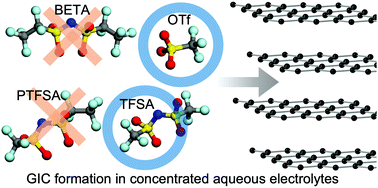Operando analysis of graphite intercalation compounds with fluoride-containing polyatomic anions in aqueous solutions†
Abstract
The formation of graphite intercalation compounds (GICs) in aqueous solutions has attracted much attention, but reversibility in the formation/deformation of GICs is a challenging issue to construct highly safe rechargeable batteries. In this study, we used an operando analysis (X-ray diffraction and Raman spectroscopy) to discuss the feasibility of using fluoride-containing polyatomic anions in the formation of GICs in aqueous highly concentrated solutions. We found that the intercalation of anions containing a C2F5 moiety (such as [N(SO2CF3)(SO2CF2CF3)]− or [N(SO2CF2CF3)2]−) does not occur in the bulk of graphite, but only in the surface region. In addition, anions containing a CF3 moiety show different behaviors: SO3CF3− shows greater reversibility and larger stage-number than N(SO2CF3)2− in the formation of GICs. These results provide design guidelines for the reversible intercalation and de-intercalation of anions and their application as a cathode material in aqueous rechargeable batteries.



 Please wait while we load your content...
Please wait while we load your content...